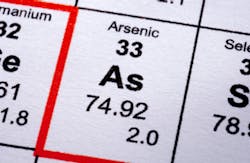Arsenic treatment advancements create profitable environment
BIRMINGHAM, Ala. — In the August issue of Water Technology, President of Applied Process Equipment Inc. Richard Sinclair discusses the importance and challenges of arsenic removal treatment in small systems.
Sinclair notes that while many dealers have avoided the market because of its past complexity, they can unlock huge sales potential by offering the service for light commercial and residential customers. Technologies now include reverse osmosis (RO), ion exchange and adsorption media.
RO may be the best option for residential applications, but they are impractical for systems with flow rates above 5 gpm.
Ion exchange provides an option equal to the cost of adsorption systems, but it also has high maintenance and operation expenses.
Adsorption media, states Sinclair, is "the most widely used media for arsenic removal from drinking water are aluminum, iron, titanium, lanthanum and zirconium metal oxides." The media form a bond with arsenic, while some are more appropriate for certain water conditions. Dealers must design systems to accommodate the required dwell time, which can vary from 20 seconds to 15 minutes.
Dealers should consider several factors regarding the adsorption method including media pH requirements, water analysis and media selection, system design, and installation and service, shares Sinclair. Any experienced installers should be able to set up the system.
Finally, explains Sinclair, the arsenic removal is growing among several markets including mobile/manufactured home parks, RV parks, schools, restaurants, resorts, medical facilities and small communities.
Click here to read the entire article.
